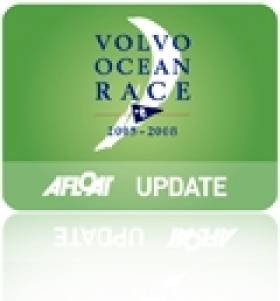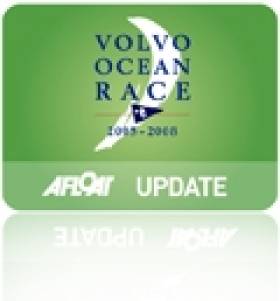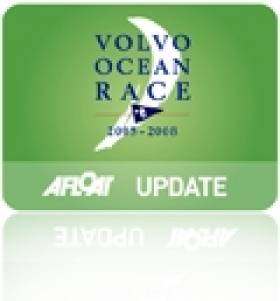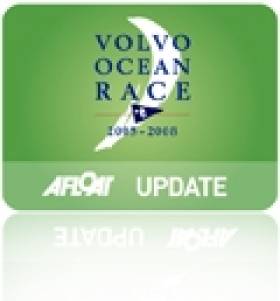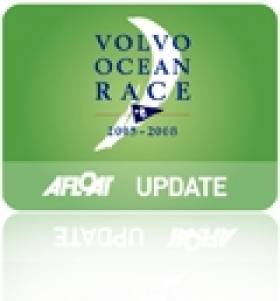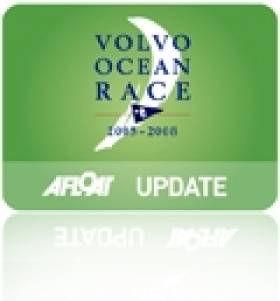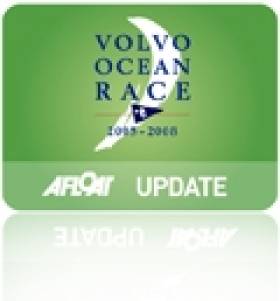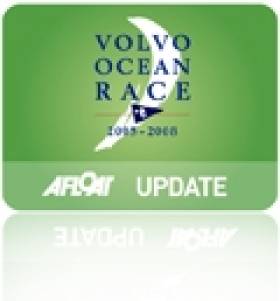Displaying items by tag: Volvo Ocean Race
Team Vestas Wind Arrives In Bergamo Ahead Of Repairs
#VOR - As Dongfeng Race team celebrate their home-port victory in the third leg of the Volvo Ocean Race from Abu Dhabi to Sanya, the grounded Team Vestas Wind are half a world away in the foothills of the Italian Alps.
Following the team's pledge earlier this month to rejoin the race before the final leg out of Lisbon this summer, the boat has completed its long journey from the Southern Indian Ocean to the Persico Marine yard near Bergamo in Italy.
That's where the damage sustained in November's devastating grounding on shoals between Madagascar and Mauritius will be assessed before the repair works begin - with only a tight four-month window to get back on the ocean.
Sail-World brings us this photo gallery compiled by the team's onboard reporter – and regular Afloat contributor – Brian Carlin charting the boat's road trip from Genoa to Bergamo, where the whole team will pitch in to get the one-design VOR 65 ship-shape once more.
One man who won't be joining them, however, is Wouter Verbraak, who last week was officially removed as navigator on the team. His replacement has yet to be named.
Dongfeng Win VOR Leg Three, Leading All the Way from Abu Dhabi to Sanya
#vor – It was an unbelievable end to a magnificent Volvo Ocean Race leg for Dongfeng Race Team. After leading the fleet virtually all the way from Abu Dhabi to Sanya in China, over more than 5,000 miles of intense ocean racing, Dongfeng finally crossed the finish line in first place as the sun rose over Sanya (23:31:38 UTC) in a time of 23 days, 13 hours, 31 minutes and 38 seconds.
This is the first time in history a Chinese team (or any Chinese sailor) has won a leg in the Volvo Ocean Race's 41-year history. And what a leg to win supported by its Chinese partners – Dong Feng meaning wind from the east, Aeolus (Fong Shen) meaning the Wind Guardian and the City of Shiyan.
The reality is that it couldn't have been scripted better. The Chinese team with two Chinese rookie sailors onboard – Liu Xue (Black) and Cheng Ying Kit – showed unparalleled grit and determination and led the entire fleet of some of the world's best offshore sailors to their home country China. With the ambition to 'bring offshore sailing to China' nobody could have predicted the impact this team would have.
Arriving at the pontoon in Serenity Marina, Charles Caudrelier said: "It was the most stressful race of my life. We take the lead on the first day and we had to keep it because we had to arrive first here because it was very important for me and for the project, so we are so proud. One year ago we were here and we were discovering the Chinese sailors who were rookies and now they win the leg – it's just fantastic. Maybe in the first time in offshore sailing something like this has happened – in just one year these guys have become great sailors. I am so proud, this is everything I wanted but I didn't dare think about. It's a team job and you cannot win a leg without a strong team."
There were moments of panic where the chasing pack were catching up and the lead did diminish (from 106 miles to 9 miles at one point). In just under 24 days and racing more than 5,000 nautical miles, Dongfeng held their position. It's the longest time any team has led the fleet since the start of the race back in Alicante in October, which is no surprise as the determination onboard Dongfeng was almost tangible as the teams left for Sanya. Dongfeng was going to fight like hell to win this leg.
Persian Gulf, Hormuz Strait, Gulf of Oman, Arabian Sea, Bay of Bengal, Andaman Sea/Malacca Straits and the South China Sea are just a few of the challenges the determined men of Dongfeng have had to face as they battled their way through leg 3. Dongfeng have shown exceptional capabilities and stamina on what has been one of the slowest and agonizing legs so far.
This is the ultimate triumph for a project that has the future of Chinese sailing at its core. The youngest sailor in the race at the age of 21, Liu Xue, could not contain his delight on the dockside: "I have made the best decision of my life to join this team. I have learnt so much. This leg and this moment I will remember and cherish for the rest of my life." As a very proud grandmother, who had never flown on a plane until she flew into Sanya for this arrival, stood close by to Black.
When it was agreed that Dongfeng Race Team would lay the foundations for offshore sailing in China no one could have predicted such a perfect result. With little under a year of training the Chinese sailors in the squad have impressed, even if this made Dongfeng Race Team one of the less experienced teams and, subsequently, the least favourite to win when the race started. So this is not only a victory for China but for Caudrelier and his men who have worked day and night to train their Chinese counterparts.
Charles Caudrelier wrote on day 12 of the leg: "I am watching them with admiration, we're leading this leg, we're at the top of the overall leaderboard – you can't compete with the race favourites without a great team. And to build a great team, you need great players. Thinking about the journey of the Chinese sailors since February 2014, Black didn't speak a word of English and had never spent a night at sea. But from the first day he really impressed us – then he quit straight away after his first offshore sailing, beaten by the brutality of the bad weather – and then a few months later he returned. To start your offshore sailing career with a Volvo Ocean Race is brutal. This afternoon I was watching him trim the sails and I realised that he's learnt thousands of details in a very short period of time. It's the same for Kit who is realising his life's dream onboard right now, his first offshore race. This evening he gave me a Chinese lesson, and it reinforced the enormity of the challenge they [the Chinese sailors] are taking on, learning in 6 months to sail and to work in a previously unknown language. I am proud of them."
The Vice President of the International Sailing Federation and China Yachting Association, Mr. Li Quanhai congratulated to Dongfeng Race Team on their victory and stated: "Dongfeng Race Team has made history. It is the best result for a Chinese team in the world of offshore sailing."
Dongfeng Race Team has delivered an outstanding result on this leg and is going to enjoy the moment! However, even though this victory has put Dongfeng at the top of the overall leaderboard, this is only leg 3 of 9 and we can only be as good as our NEXT result.
Dongfeng Race Crew Leg 3:
Charles Caudrelier, Skipper (FRA)
Pascal Bidegorry, Navigator (FRA)
Cheng Ying Kit (Kit) (CHN)
Liu Xue (Black) (CHN)
Thomas Rouxell (FRA)
Kevin Escoffier (FRA)
Eric Peron (FRA)
Jack Bouttell (ENG/AUS)
Sam Greenfield, Onboard Reporter
Volvo Ocean Race Leg Three Sets Up For Thrilling Finish in Sanya, China
#vor – A thrilling finish looks to be in store for Leg 3 of the Volvo Ocean Race after the chasing pack made big inroads into Dongfeng Race Team's once huge lead early on Sunday with just over 24 hours to sail to the finish in Sanya.
Charles Caudrelier's (FRA) crew led by more than 106 nautical miles (nm) approaching the Malacca Strait but gradually their advantage has been clawed back with under 350nm left of this fascinating stage from Abu Dhabi to Sanya on the southernmost tip of China.
Understandably, the French skipper and his team have been feeling the pressure as the chasing pack led by Abu Dhabi Ocean Racing (Ian Walker/GBR) threatened their hopes of becoming the first Chinese-backed team to win a leg in offshore sailing's most prestigious round-the-world race.
Victory in the 4,670nm stage, which started on January 3 in Abu Dhabi, would also put Dongfeng Race Team top of the overall standings on five points ahead of Abu Dhabi Ocean Racing and Team Brunel who won Legs 1 and 2 respectively.
"Onboard Dongfeng we must stay concentrated ... the finish line is still a long way away," Caudrelier had warned in a blog from the boat as the fleet headed towards the Vietnamese coast before the weekend.
At 1240 UTC on Sunday, they had a lead of 34nm over Leg 1 winners Abu Dhabi Ocean Racing with Team Alvimedica (Charles Enright/USA), MAPFRE (Xabi Fernández/ESP) and Team Brunel (Bouwe Bekking/NED) hot on their heels too within 50nm of the Dongfeng boat.
Team SCA (Sam Davies/GBR) have been making good gains too, lying 69.2nm behind the leaders.
Game face: Justin Slattery is focused on closing out a podium place on Leg 3. #inabudhabi #goazzam #VolvoOceanRace pic.twitter.com/ymSXZzLAWk
— AbuDhabiOceanRacing (@ADORlog) January 25, 2015All the fleet had been slaloming back and forth with gybe after gybe to avoid the numerous obstacles, including a series of near misses with fishing vessels and their nets just off the Vietnamese coast.
Walker described that process during Saturday night as "possibly the single hardest night of the race" while Enright went further: "It was the most intense night of sailing of my entire life."
The sailors are heading for an amazing welcome in Sanya. The Race Village opened on Saturday to large crowds and is sure to repeat last edition's (2011-12) fantastic receptions for the fleet no matter what time of day or night they arrive.
Big Spread In VOR Fleet But 'It's Not Over Till It's Over'
#VOR - Some 160 nautical miles separate the first and last place boats in the Volvo Ocean Race as the fleet plies the South China Sea towards their destination of Sanya.
But it's not over till it's over, as race leaders Dongfeng Race Team know all too well after the job broke loose yesterday evening (22 January), threatening to ruin the sail and take them out of the running.
Quick thinking and teamwork among the international crew saved the day, as Jonno Turner reports on the official race website, and they've been able to maintain their commanding lead – currently more than 56 nautical miles ahead of second-place Abu Dhabi Ocean Racing.
Despite the spread, however, the race is as competitive as ever. Just ask the boat holding up the rear, the all-women Team SCA – who are emphasising the positives over the negatives, such as the challenges of navigating the Malacca Strait and rounding Singapore.
The VOR website has more on the story HERE.
Team Vestas Wind to Change Navigator for Volvo Ocean Race
#teamvestas – Team Vestas Wind today announced that navigator Wouter Verbraak is no longer a member of the crew for the Volvo Ocean Race.
The Dutchman was on board when the team was run aground on November 29 during Leg 2 on a reef in the middle of the Indian Ocean, causing major damage.
In the same announcement, Team Vestas Wind also stated that the remaining members of the crew would continue helping the team with the boat repair process at Persico's boatyard in Italy before their planned return to the race in June for the final two legs from Lisbon under skipper Chris Nicholson.
A statement issued early on Friday said: "Chris Nicholson has completed his review, together with the lead sponsor Vestas and sub-sponsor Powerhouse, and the decision has been made that Wouter Verbraak will no longer continue as navigator of the Vestas Wind.
"Team Vestas Wind will be joined by a new navigator in time for the Lisbon stopover and Leg 8 start in June. Team Vestas Wind would like to thank Wouter for his service and wish him well in the future."
Verbraak, in a statement, added: "I am very sad to announce that I have been notified that I will not continue with Team Vestas Wind.
"I respect Chris Nicholson's decision and wish the team the very, very best of luck with the hard work ahead of them in the Volvo Ocean Race. I would have wanted to help the team getting back in the race again and contribute to their success in the last parts of the race.
"On a personal note I am looking forward to the new sailing challenges that are coming up for me in the months ahead and want to keep sharing the passion that I have for this great sport with you all.
"Someone recently told me: 'Life is not about how many breaths you take, but about the moments that take your breath away'. I am looking forward to the new breathless moments to come. Ocean racing tends to offer many of them."
The remaining shore and sailing crew will continue to work as integral members of Team Vestas Wind, and will use their skills to assist Persico in the boat repair process.
They will also support the team at stopovers before Lisbon to keep Team Vestas Wind at the centre of race activities. The crew were grounded on a reef near St Brandon archipelago in the Indian Ocean. The boat was badly damaged but was retrieved just before Christmas.
It is expected to arrive on a Maersk Line ship in Genoa, Italy on Sunday and then be transported with the help of race sponsors GAC Pindar to Persico's boatyard in Bergamo for the rebuild to start in earnest.
Abu Dhabi's Former VOR Yacht Destroyed By Fire
#VOR - Abu Dhabi Ocean Racing's former Volvo Ocean Race yacht has been destroyed by a fire at its shipyard in France.
As Italian nautical news site Solovela reports, firefighters battled through incredible heat and toxic fumes last Friday night (16 January) to put out the blaze that engulfed the VOR 70 Azzam.
The yacht – which placed fifth in the last edition of the Volvo Ocean Race with a crew including current race skipper Ian Walker and bowman Justin Slattery – was being stored in a shed at a naval shipyard in Cogolin, on the French Riviera near Saint-Tropez.
The intense heat of the fire left little to salvage from the Italian-built yacht, melting most of the hull and leaving only the boom intact.
Team SCA In High Spirits After In-Port Race Win As Volvo Ocean Race Fleet Enters Gulf Of Oman
#VOR - The Volvo Ocean Race fleet prepares for a day of drifting in light winds as the they enter the second 24 hours of the third leg from Abu Dhabi to Sanya.
Now past the Musandam Peninsula and Strait of Hormuz and sailing into the Gulf of Oman, Dongfeng Race Team lead the pack this morning after some thrilling overnight back-and-forth with closest rivals Abu Dhabi Ocean Racing and Team Brunel.
But MAPFRE was hot on the latter's heels as of 9.40am this morning (4 January), and Team SCA is coming round on the port side of the fleet to grab fourth position with the current highest average speed of 3.2 knots.
The women on board that boat will surely be elated with their performance, coming off a hard-fought victory in yesterday's in-port race in Abu Dhabi.
That was an achievement more remarkable for the loss of bowman Sophie Ciszek, who will miss out on this third leg with a back injury.
"There's been some big changes," said Ciszek from the SCA pavilion, "we had a big debrief, it's really good to turn it around and win the in-port."
Team Vestas Wind Pledge To Rejoin Volvo Ocean Race
#VOR - The grounded Team Vestas Wind have declared their intention to rejoin the Volvo Ocean Race at some point before the final leg out of Lisbon this summer.
Team chief executive Morten Abaek and skipper Chris Nicholson made the announcement at last night's VOR Life at the Extreme awards in Abu Dhabi as the rest of the fleet prepared for today's first in-port race ahead of the third leg to Sanya in China.
According to The Wall Street Journal, the team's boat – which surprised the sailing world when it ran aground on shoals in the Indian Ocean between Madagascar and Mauritius in late November – is in better condition than expected, and plans are in motion for rebuilding and repair works at an Italian shipyard.
Though the beleaguered team will have no chance of topping the table if they do get their boat back in the race, it would be a testament to their spirit if they indeed can get the show back on the seas.
“This gives us the opportunity to perform one of the biggest comebacks in sailing and prove to the world who we are,” said Albaek.
And Ireland's own Brian Carlin, as the team's on-board reporter, will surely be there to document every step along the way.
The Wall Street Journal has more on the story HERE.
Team Alvimedica Get Redress For Time Lost Assisting Vestas Crew
#VOR - Team Alvimedica have won a claim for redress over time lost while diverting to assist the stricken Team Vestas Wind during the second leg of the 2014-15 Volvo Ocean Race, according to the official race website.
As previously reported on Afloat.ie, the American-led team altered course to assist their race opponents after the Team Vestas yacht grounded on shoals in the Indian Ocean between Madagascar and Mauritius on 29 November.
The Alvimedica crew stood on standby till they were cleared to continue racing north when it was determined the Vestas team were in no immediate danger.
They eventually came in fifth of out of the six finishers when they arrived in Abu Dhabi on 14 December.
However, an independent jury hearing held by the ISAF has ruled that Team Alvimedica were cost a race position, both by the time they lost stopping to assist their fellow competitors and by missing out on the remnants of a tropical storm that boosted their rivals on approach to the UAE.
The team received an extra point, bringing their total to four, without affecting the finishing positions of the rest of the fleet.
“It’s nice to have the point but it’s a small step in a big journey," said Team Alvimedica skipper Charlie Enright. "It doesn’t change the overall standings currently, it doesn’t affect the positions of the other boats in the last leg, but later a point could be fairly big."
The VOR website has more on the story HERE.
#VOR - Though currently holding last place in the seven-boat fleet competing in the 2014-15 Volvo Ocean Race, the all-women Team SCA remains focused the task at hand - not only completing the 38,000-plus-mile round-the-world challenge, but charting a new course for women in the male-dominated sphere of offshore sailing.
That's the message loud and clear in Chris Museler's profile of the team for The New York Times, which paints a picture of a dedicated crew who are far from the 'B team' status that female squads have been subject to in previous races.
In particular, the experience of VOR vet and Team SCA crew member Abby Ehler in the 2001-02 edition of the race – in which she was captain and bowman on Amer Sports Too, but reportedly given little control over campaign decisions by manager (and skipper of the male 'A' team boat) Grant Dalton – was telling of women's virtual absence from the VOR for more than a decade.
“I don’t think that helped women’s sailing," said Richard Brisus, MD of Team SCA. "There was an effect on recruitment this time because of that. But when SCA launched in 2012, women realised that this is not a PR stunt. This is our chance, and it’s not a ‘B’ team.”
The New York Times has much more on the story HERE.


























